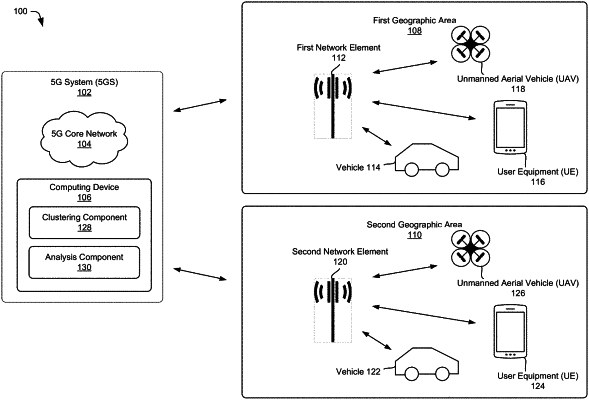| CPC H04W 24/02 (2013.01) [H04W 4/029 (2018.02); H04W 16/18 (2013.01)] | 20 Claims |

|
1. A method comprising:
receiving network configuration data associated with a telecommunication network associated with an environment, the network configuration data identifying a deployment infrastructure including an angle of a network element of the telecommunication network relative to a geographic coordinate system;
receiving network user data indicating an access type for multiple user equipment (UEs) associated with the telecommunication network;
receiving first location data indicating positions of the multiple UEs relative to the network element;
receiving second location data indicating a position of the network element in the environment;
inputting the network configuration data, the network user data, the first location data, and the second location data into a machine learned model;
receiving, from the machine learned model, an output indicating, in a common coordinate system, a first cluster and a second cluster different from the first cluster, the first cluster associated with a first distribution of the multiple UEs and the second cluster associated with a second distribution of the multiple UEs, the common coordinate system generated by normalizing the geographic coordinate system; and
determining, by the machine learned model and based at least in part on the first distribution and the second distribution, network parameters associated with peak throughput for the multiple UEs associated with the telecommunication network.
|
|
8. A system comprising:
one or more processors; and
memory storing computer-executable instructions that, when executed by the one or more processors, cause the system to perform operations comprising:
receiving, by a machine learned model, input data comprising two or more of:
network data representing attributes of a first network element associated with a telecommunication network, the network data including network configuration data identifying a deployment infrastructure including an angle of the first network element relative to a geographic coordinate system;
position data representing positions of multiple user equipment (UEs) relative to the first network element and a position of the first network element relative to a coordinate system;
user data representing an access type or an access rate of a UE associated with the telecommunication network; or
map data representing features of an environment of the telecommunication network;
determining, by the machine learned model, a first numerical value indicative of a percentage distribution of the multiple UEs in a first cluster in a common coordinate system and a second numerical value indicative of a percentage distribution of the multiple UEs in a second cluster in the common coordinate system, the second cluster different from the first cluster, the common coordinate system generated by normalizing the geographic coordinate system; and
determining, by the machine learned model and based at least in part on the first numerical value and the second numerical value, network parameters associated with peak throughput for the multiple UEs associated with the telecommunication network.
|
|
16. A method comprising:
receiving first data associated with a first network element of a telecommunication network, the first data including first network configuration data identifying a deployment infrastructure associated with the first network element including an angle of the first network element relative to a geographic coordinate system, the first network element associated with first multiple user equipment (UEs);
receiving second data associated with a second network element of the telecommunication network, the second data including second network configuration data identifying a deployment infrastructure associated with the second network element including an angle of the second network element relative to the geographic coordinate system, the second network element different from the first network element and associated with a second multiple user equipment (UEs);
inputting the first data and the second data into a machine learned model;
receiving, from the machine learned model and based at least in part on the first data and the second data, an output indicating, in a common coordinate system, a first cluster and a second cluster different from the first cluster, the first cluster associated with a first distribution of the first multiple UEs and the second cluster associated with a second distribution of the second multiple UEs, the common coordinate system generated by normalizing the geographic coordinate system;
determining, by the machine learned model and based at least in part on the first distribution and the second distribution, a similarity between the first network element and the second network element; and
determining, by the machine learned model and based at least in part on the similarity, a parameter for the first network element or the second network element to cause peak throughput for the first multiple UEs or the second multiple UEs.
|